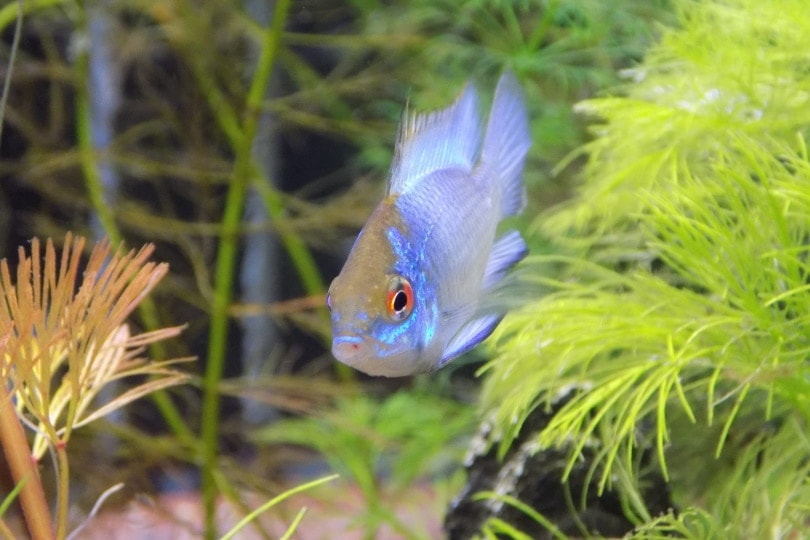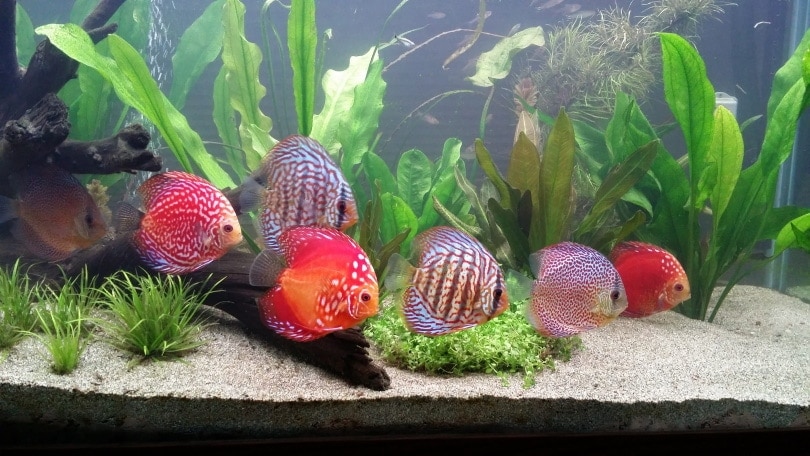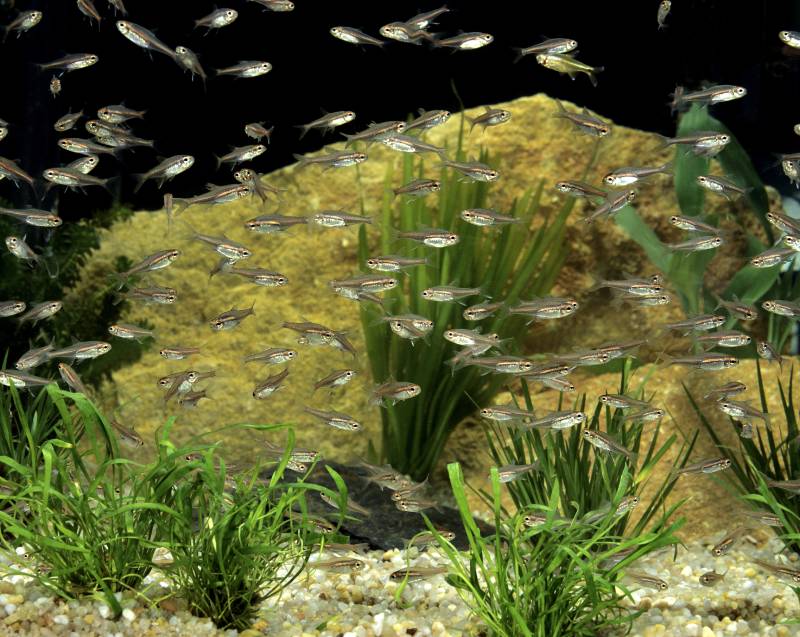10 Great Tank Mates for Cherry Shrimp (Vet Answer)
By Dr. Luqman Javed, DVM (Vet)
Updated on
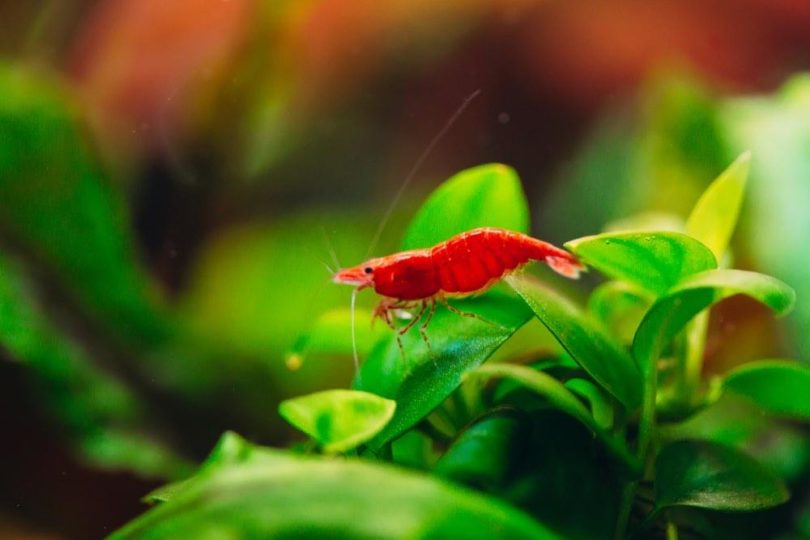
Cherry shrimp are popular pet shrimp because of their bright colors and peaceful disposition. They’re a fantastic option for nano tanks, as heavily planted nano aquariums are a suitable setup for them, and in instances where space is limited, a nano aquarium with colorful cherry shrimp makes for a very intriguing, colorful aquarium.
Some people wish to keep cherry shrimp in a community setup. This brings with it a problem: many freshwater fish will readily eat shrimp. Finding appropriate tank mates means ensuring that they’re compatible with the water parameters your shrimp appreciate and making sure they don’t view your precious shrimp as a meal.
In this article, we’ll explore some tank mate options for cherry shrimp.
Checklist for Cherry Shrimp Tank Mates
When housing cherry shrimp with other fish, the primary concern, as mentioned earlier, is ensuring that your cherry shrimp are viewed as community mates and not a snack. The checklist below will help you determine, at a quick glance, if the fish you’re curious about are possible candidates for cherry shrimp.
The checklist for a cherry shrimp’s potential community mate include the following:
- Aquarium Size: Though cherry shrimp can be housed in nano tanks, many of their compatible tank mates, while small, often require relatively large aquariums and enjoy swimming space. You need to ensure that your tank is large enough to accommodate all your fish.
- Current Compatibility: Because cherry shrimp young can easily be caught in a filter’s intake, they’re often housed in aquariums with delicate sponge filters. Sponge filters do produce a current in the water; however, it isn’t an exceptionally strong current. The fish you select as tank mates for your cherry shrimp should be comfortable in low to moderate currents.
- Tropical Fish: As cherry shrimp are tropical, they can only be housed with tropical freshwater fish.
- Non-Predatory: Many fish view shrimp as a snack. Predatory or carnivorous fish cannot be housed with cherry shrimp as they may not be able to distinguish between a tank mate and a potential meal. Fish that are omnivores need to be assessed on an individual basis.
- Non-Aggressive: Fish housed with cherry shrimp should not be aggressive or display territorial aggression. This includes fish that have tendencies to become aggressive when they attempt to spawn, such as the German ram cichlid.
- Similar Water Preference: Cherry shrimp appreciate a water pH of around 6–8 (7 being ideal). Fortunately, this pH is acceptable to most other freshwater fish. They enjoy temperatures between 69.8–80.6°F (21–27°C). They are very flexible with water hardness, tolerating ranges from 5–15 dH. Potential community mates should be compatible with these parameters.
- Plant Compatible: Cherry shrimp appreciate densely populated aquariums. The fish you consider as a tank mate must be compatible with freshwater plants. Though most fish appreciate plants in their aquarium, a few species are notorious for uprooting, eating, and destroying plants.
Please note that all these criteria are to be met before a tank mate can be considered for your cherry shrimp.
A Note About Young Cherry Shrimp : When housing a cherry shrimp colony, breeding is almost always a certainty. Cherry shrimp do not eat their own young. Female cherry shrimps that are holding young shrimplets are often slightly aggressive and skittish. Though cherry shrimp do not eat their own young, other fish that are compatible with adult cherry shrimp may attempt to eat young cherry shrimp.
The list of tank mates we’ve provided considers compatibility with adult cherry shrimp, though many of these candidates may also be compatible with baby shrimp.
Top 10 Tank Mates For Cherry Shrimp
1. Neon Tetras (Paracheirodon innesi)
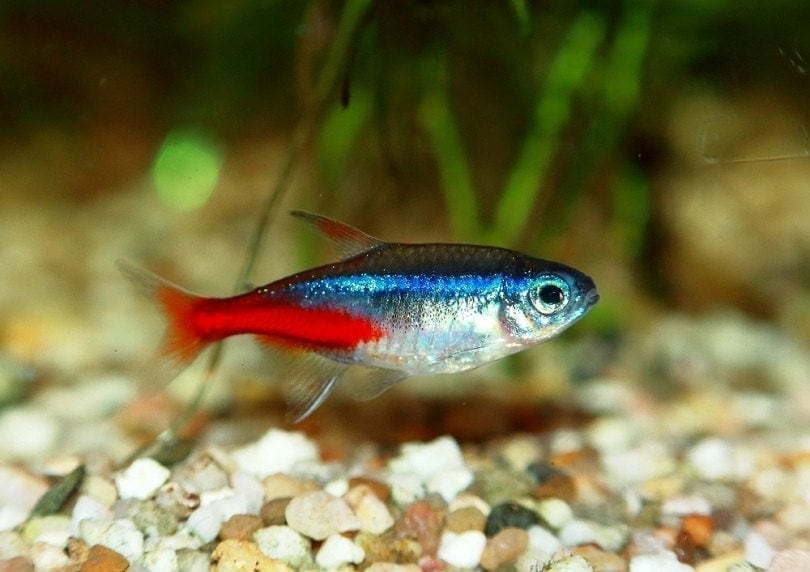
| Size: | 5 inches (4 cm) |
| Diet: | Omnivores |
| Minimum tank size: | 10–15 gallons for a school of 6–10 individuals |
| Care Level: | Easy |
Neon tetras are small colorful fish that are easily identified by an iridescent blue horizontal stripe along each side of the fish from the nose to the base of the adipose fin and an iridescent red stripe that begins at the middle of the body and extends to the base of their caudal fin. At night, the blue and red become gray or black as these fish sleep. To the amusement of fish keepers, their neon and red colors reactivate once they become active in the morning.
They stay relatively small and prefer to live in groups of at least five other neons, though they are best in groups of 12 or more. They are known for being peaceful fish that prefer to hang out at almost all levels of the aquarium. They are best housed in a densely planted aquarium, which mimics their natural habitat.
Neon tetras are susceptible to neon tetra disease, a contagious protozoan disease that is incurable and, despite its name, doesn’t just affect neon tetras. However, the disease is easily preventable with proper quarantine protocols before adding new fish into an existing community tank.
2. Green Neon Tetra (Paracheirodon simulans)
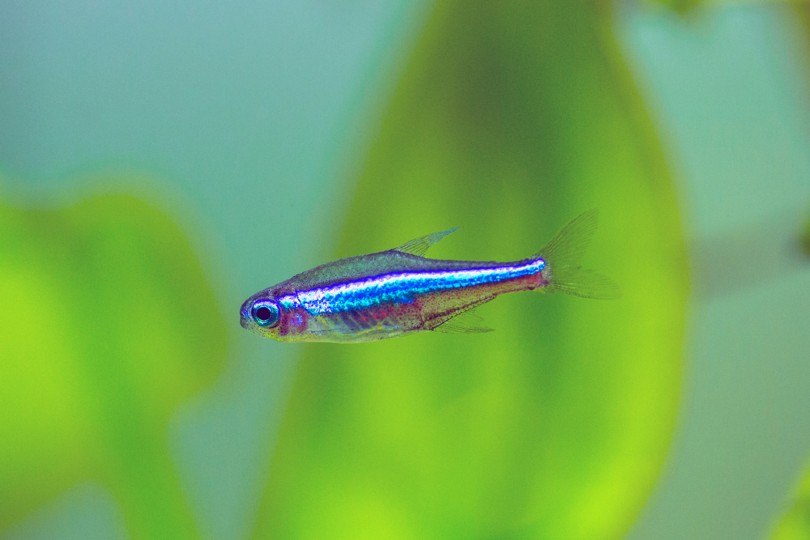
| Size: | 4 inches (3.5 cm) |
| Diet: | Omnivores |
| Minimum tank size: | 10–15 gallons for a school of 6–10 individuals |
| Care Level: | Easy |
Despite the name similarity with the aforementioned neon tetra, the green neon tetra isn’t a variant of the neon tetra and instead is an entirely different species. If the colors of the neon tetra aren’t to one’s liking, these fish can be considered as an alternative for cherry shrimp tank mates.
Green neon tetras are slightly slimmer than neon tetras. Their red stripe is less pronounced than that of neon tetras, while conversely, their blue-green stripe is more brilliant than the coloration of neon tetras. Like neon tetras, they temporarily lose their colors at night but regain them during the day.
3. Cardinal Tetra (Paracheirodon axelrodi)
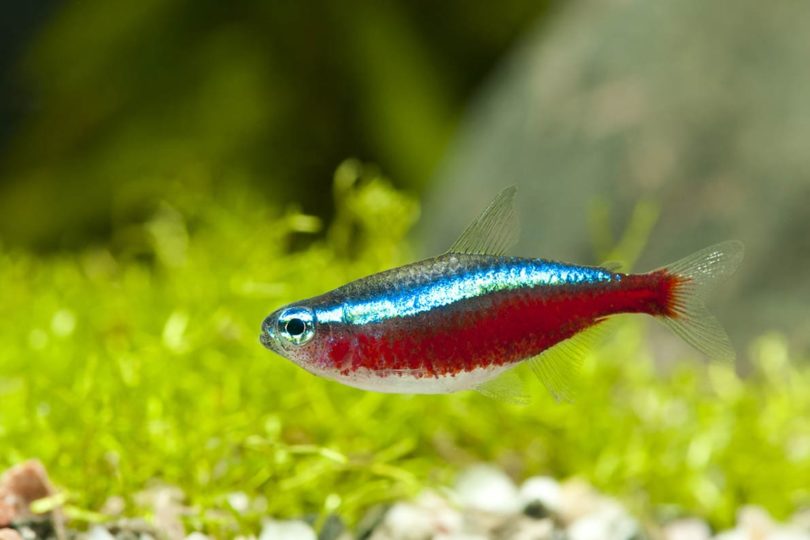
| Size: | 2 inches (5 cm) |
| Diet: | Omnivores |
| Minimum tank size: | 15–20 gallons for a school of 6–10 individuals |
| Care Level: | Easy |
A third tetra option is the cardinal tetra. Similar to the green neon tetra, these fish closely resemble neon tetra but are a different species. They are named for their iridescent blue line running along the top half of their body, with the body below this line being vivid red in color. Unlike the neon tetra, their red stripe runs along the entire length of their body. Like other tetras, they school and appreciate large numbers of their conspecifics in an aquarium. These fish will not school with neon tetras despite appearing similar.
The cardinal tetra has a few different color forms. A gold and silver-blonde form exists, though this color variant is not readily found in most pet stores. These fish appreciate slow-moving currents and are a viable option for community fish housed with cherry shrimp.
4. Otocinclus Catfish (Otocinclus)
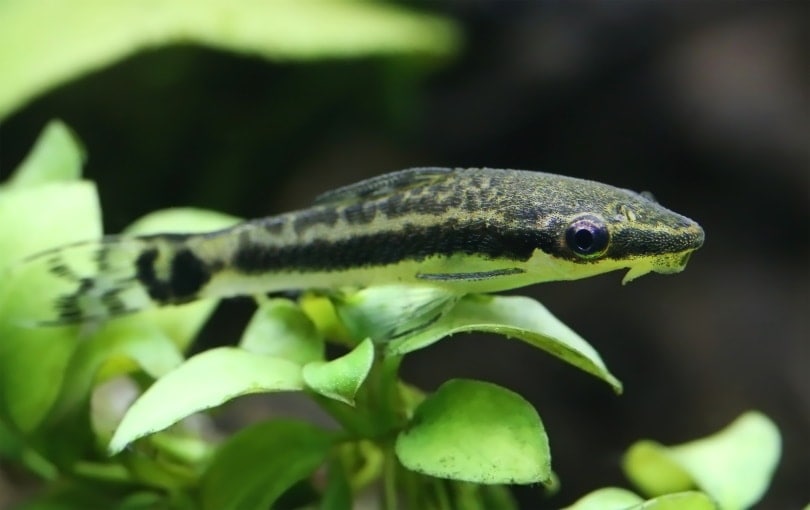
| Size: | Up to 2 inches (5 cm) |
| Diet: | Herbivores |
| Minimum tank size: | 15–20 gallons for a school of 6–10 individuals |
| Care Level: | Intermediate |
Among the long, extensive list of “suckerfish” that you could consider housing with cherry shrimp, otos are by far the best. Unlike most other species of catfish, they are herbivores. This means they would not show an interest in baby cherry shrimp.
In addition, they stay relatively small and are a great addition to a small aquarium. They do need to be kept in groups, though, as they are schooling fish. Like the cherry shrimp, they prefer a low to moderate current.
Care is advised when housing otos; despite them being labeled as “algae eaters”, they require a nutritious diet catered especially for them. They do not readily eat foods intended for omnivores or carnivores and are considered slightly more complex to care for.
5. Apple Snails (Pomacea bridgesii)
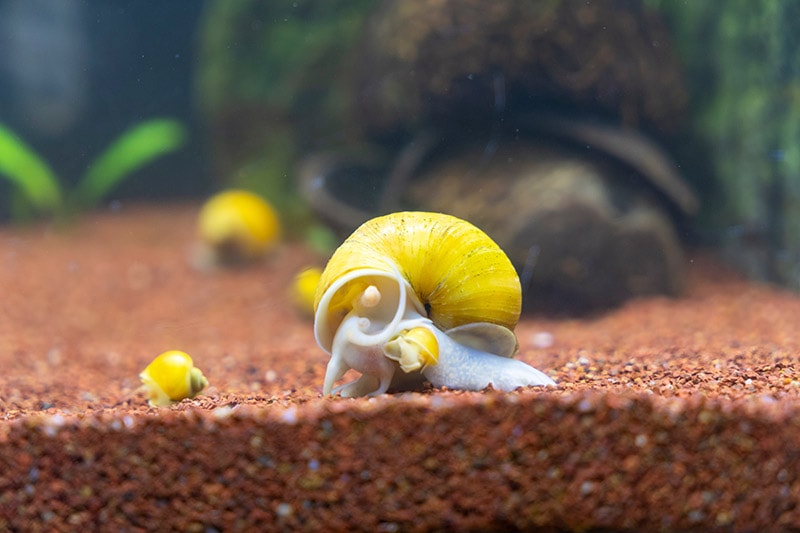
| Size: | Shell may reach up to 6 inches in diameter (15 cm) |
| Diet: | Omnivores |
| Minimum tank size: | 10 gallons |
| Care Level: | Beginner |
Though many snails are compatible with cherry shrimp, apple snails are a popular choice because they do not breed as rapidly as other species of snails when kept in captivity.
This is because they are gonochoristic, which means that each individual is either male or female. Many other species of snails are hermaphrodites, and a single individual can quickly multiply and cause unwanted population spikes in an aquarium.
When kept as pets, they are interesting because they are among the largest freshwater snails. They are sometimes referred to as mystery snails (though the two are different species).
6. Panda Cory (Corydoras panda)
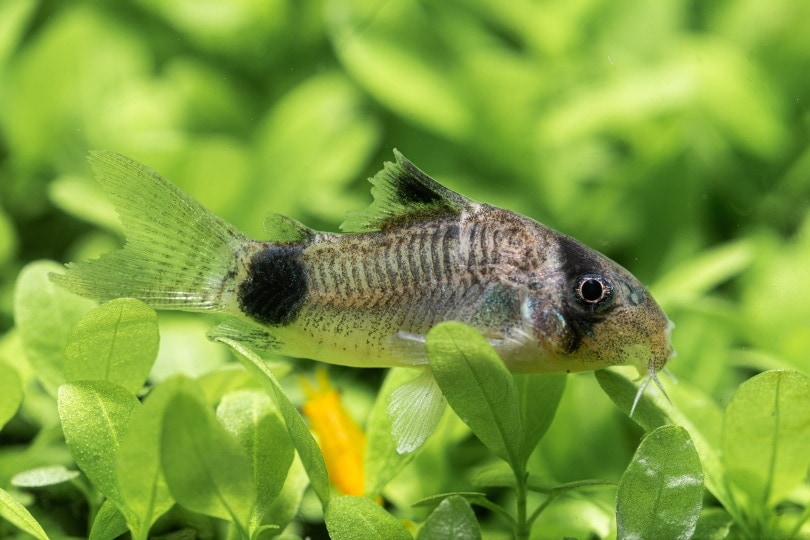
| Size: | Females are larger and may reach up to 2 inches (5 cm) |
| Diet: | Omnivores |
| Minimum tank size: | 20 gallons for a school of 6–8 |
| Care Level: | Intermediate |
Of the various corydoras species, the panda cory is by far one of the safest options as far as cherry shrimp compatibility is concerned. These fish are relatively small, with adult females (which are larger than males) reaching a length of about 2 inches. They are named for the large black patches surrounding their eyes, reminiscent of those found on the giant panda.
These fish are an interesting species for those looking for a slightly more complex community setup and perhaps those interested in a fun challenge when it comes to setting up a community aquarium.
This is because, though they are tropical, they prefer slightly cooler temperatures ranging from around 68°F (20°C) to 77°F (25°C). In addition, they require a soft or smooth-edged substrate, as they spend most of their time near the bottom of the aquarium. They also appreciate floating plants, as they are fond of the shade such plants provide. They also enjoy live feed; bloodworms, brine shrimp, and tubifex worms are popular options. These live feeds should be cultivated at home to minimize the risk of introducing unwanted pathogens into a community aquarium. These requirements present a somewhat interesting challenge for those seeking an interesting aquarium setup.
Caution is advised; while these fish are compatible with adult cherry shrimp, but might view baby cherry shrimp as a snack.
7. Pygmy Cory (Corydoras pygmaeus)
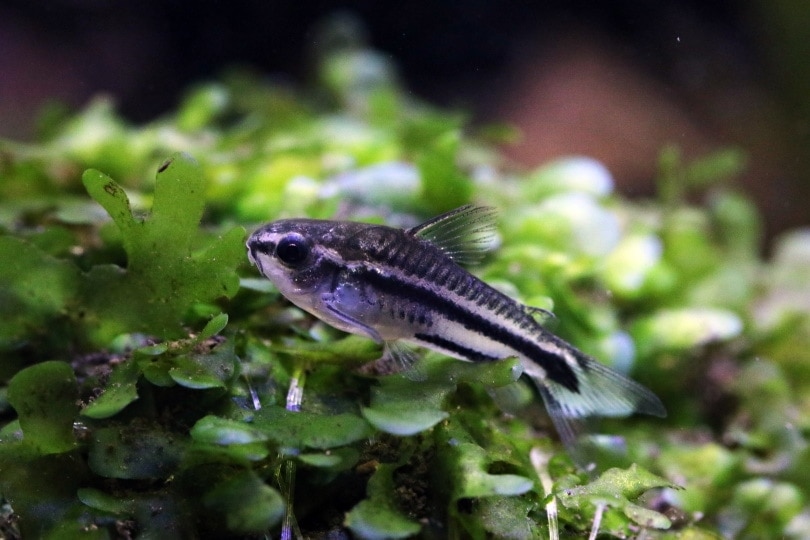
| Size: | Females are larger and may reach up to ~1 inch (2.5 cm) |
| Diet: | Omnivores |
| Minimum tank size: | 20 gallons for a school of 6–8 |
| Care Level: | Intermediate |
An alternative to the Panda cory is the even smaller Pygmy cory. These specimens only reach about an inch in size if they’re female, with males being even smaller. Their popularity is attributed to their small size and their schooling pattern. Unlike most larger species of corydoras, pygmy cories tend to swim more closely and therefore are appreciative of large numbers of their conspecifics.
Like cherry shrimp, they are not compatible with aggressive tank mates. They also appreciate a very fine substrate – grained substrate such as sand is best. Such soft substrate allows them to dig through the substrate without risking injury to their barbels.
8. Harlequin Rasboras (Trigonostigma heteromorpha)
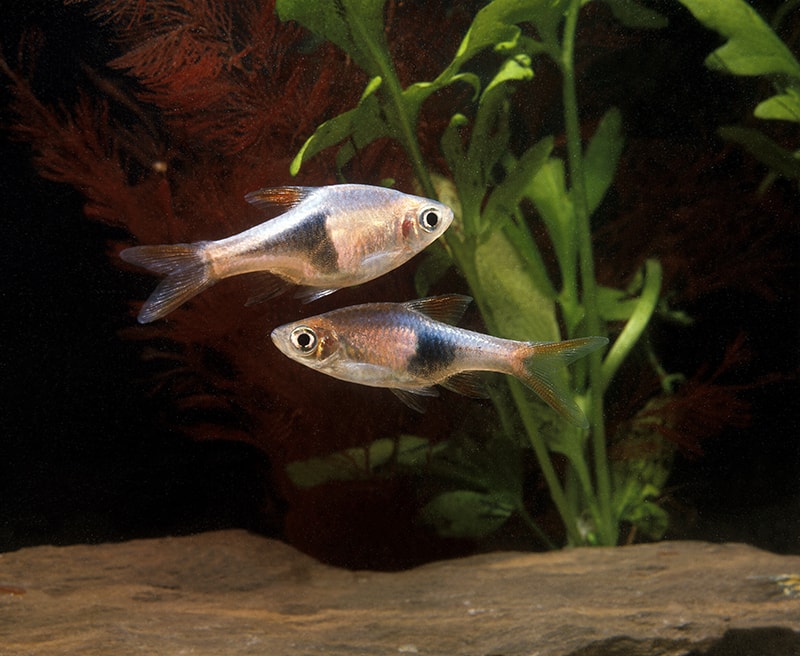
| Size: | 2 inches (5 cm) |
| Diet: | Omnivores |
| Minimum tank size: | 25 gallons for a school of 15 or more |
| Care Level: | Beginner to Intermediate |
The harlequin rasbora is a popular peaceful shoaling fish. Known for their lozenge-shaped body and signature black “wedge” near their tail, these fish are a fantastic addition to any peaceful tropical aquarium.
Though they are very easy to care for, they pose a somewhat interesting challenge for fish keepers who intend to undertake an aesthetically pleasing challenge. Though they are capable of being kept in groups of about 6 to 8 individuals, the true beauty of this species is seen when they’re kept in larger groups.
A large school of harlequin rasboras presents a striking view, even to non-fishkeepers, and their active disposition in the water adds to the spectacle. Setting up a large community aquarium comes with other fun challenges, but it’s often well worth it when these fish are seen swimming in large numbers.
9. Zebra, Longfin Zebra, or Leopard Danio (Danio rerio)

| Size: | 2 inches (5 cm) |
| Diet: | Omnivores |
| Minimum tank size: | 15–20 gallons for a school of 6–10 individuals |
| Care Level: | Beginner |
Danios are among the hardiest pet fish around the world. Though often used in scientific research, they make fantastic pets as well. Interestingly, the zebra, longfin zebra, and leopard danio are the same species and the names attributed to them based on their patterns are for identification purposes only.
When housed together, they all will readily school with each other. This can add a touch of variety to an aquarium where patterns are desired. Their popularity is further accentuated by their playful disposition and broad availability.
Zebra danios were used to make genetically modified fish and were the first species to be sold as GloFish (fluorescent-colored fish). GloFish can be housed with other danios as well, and, despite their color differences, they will shoal with “regular” danios!
10. Guppies (Poecilia reticulata)
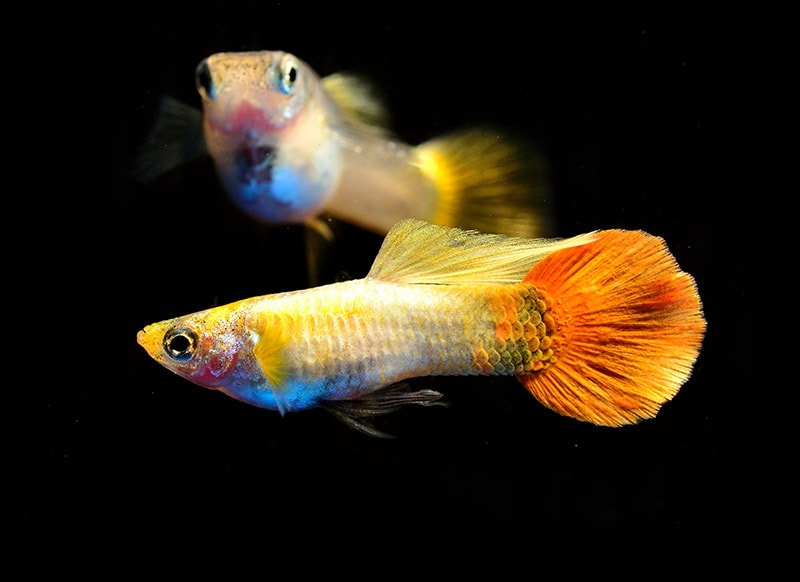
| Size: | Females can reach up to 2.5 inches (6 cm) |
| Diet: | Omnivores |
| Minimum tank size: | 5 gallons for an individual |
| Care Level: | Intermediate |
Guppies are eye-catching fish that come in a variety of patterns and colors. They usually swim near the top level of the aquarium and should not notice the cherry shrimp. Guppies are a great choice of fish for those wanting to add color and beauty to their cherry shrimp tank in a nano tank. This is because, unlike most other small fish, guppies can be housed in smaller numbers. They are shoaling (social) fish, but they don’t school.
When housed in groups, it is important to note that they readily breed. Males are notorious for constantly chasing females in an attempt to breed; therefore, a ratio of two females per male is advised, with more females per male being even better. They can also be housed in a single-sex setup if breeding isn’t desired. Guppies are prolific but lack parental instincts; they will readily eat their young whenever the opportunity arises.
In Summary
Keeping shrimp with peaceful and small fish is the best option to establish a community for all the inhabitants within the tank. Always make sure that you have the correct water conditions according to the species of fish or invertebrates you decide to keep with your cherry shrimp.
We hope this article has helped you choose a suitable tank mate for your cherry shrimp colony.
Featured Image Credit: Pavaphon Supanantananont, Shutterstock




